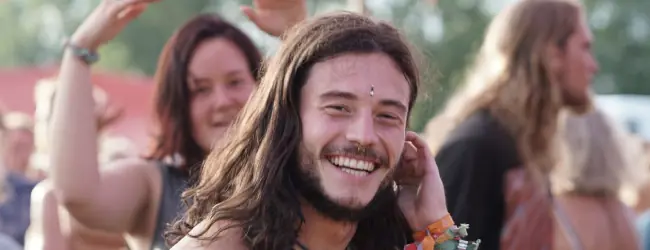Let’s talk about something a little different. Today, I will introduce the face types based on characteristics. It could be wrong because I am still developing this theory. But I think this might be useful for something.
Why can we judge based on our first impression?
When I meet a person, I sometimes feel, “Perhaps this person and I have good chemistry.” Or, “Perhaps I don’t like this person.” I can understand that right after I see them. And that is often right. Perhaps you also experienced such curious feelings.
Sometimes, we can feel such first impressions. I wondered why we could judge their personalities with it even though we didn’t communicate with each other at all.

It might be some spiritual connection. But in my opinion, perhaps we can judge their personalities by their faces. You may also have heard of such a facial tendency. For example, a rounded face is harmonious, or an oval, long face is nervous. So, I thought about what elements show us their personalities.
And at last, I succeeded in describing them in words. So today, I will explain the face types based on personality.
The Face Types by Personalities
The face types are as follows: (Attention: These are extreme examples. Almost all of us are in the middle of them.)
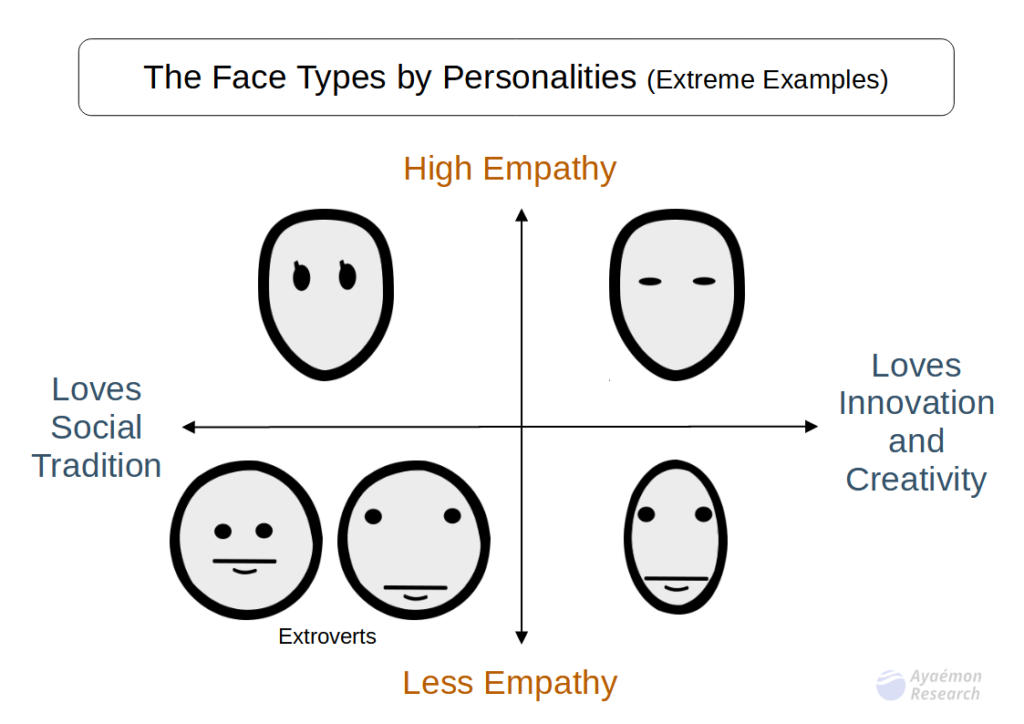
Two axes of classification
I classify our characteristics on two axes, as follows:
- Those who have high empathy or less empathy.
- Those who love social tradition or love innovation with creativity.
The lower the left, the more extroverted the personality. And the higher the right, the more introverted the personality. In our society, extroverts are the majority.
The faces of less empathic
So, let me explain each facial type. We treat highly empathic and less empathic people separately.
First, let’s see the faces of the lower side, those of less empathetic people.
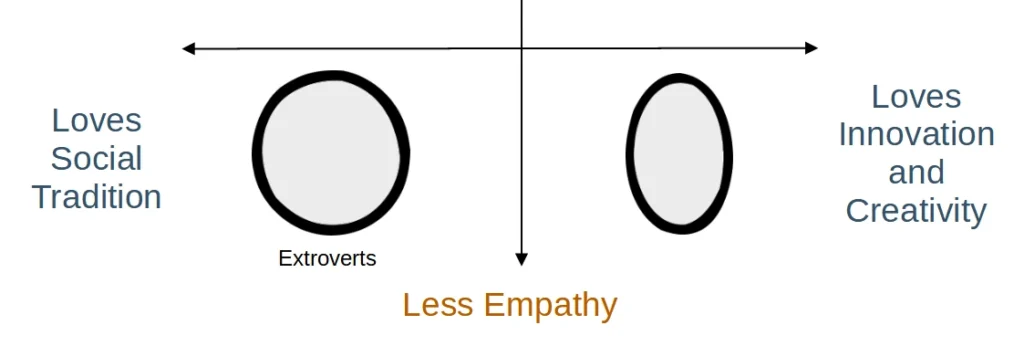
We can classify them by face shapes.
- The more people who prefer to follow social traditions, the more rounded or squared faces they tend to have.
- The more innovative and creative they are, the more long-oval faces they tend to have.
This may be a factor of people saying, “A rounded face is harmonious.” Or, “an oval, long face is nervous.” They often insist on their way because they are less empathetic. So, the more people who want improvements, the more they insist on change or modification for society. That sounds nervous for extroverts, those who like following social tradition.
The faces of extroverts
And there is a difference in such extroverts.
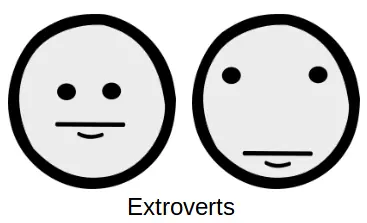
- The facial parts are more centered: Those who tend to have self-control and can follow the rules. However, it tends to be hard to adapt to environmental changes.
- The facial parts are more outer: Those who tend to be able to adapt to environmental changes. However, it tends to be hard to self-control and follow the rules.
Extroverts type 1: The more centered face parts

People with this type of face have self-control and can follow the rules. In other words, they can take responsibility.
So, if these people are in a good environment with strict rules and controls, they often show their ability to contribute to society.
This type often succeeds at a young age in traditional areas because they can follow the rules. There are often rational rules in these traditional areas. And they are bearable enough to follow them.
Sometimes, people with this type could succeed in a business with the latest technology. They will be the people of the times. But after the environment changes, they tend to fail and impact their society.
An extreme example is those who have autism spectrum disorder (ASD). Some of them tend to have this face. They can follow the rules with self-control.
Extroverts type 2: The more outer-side face parts

People with this type of face tend to live thoughtlessly, for better or for worse. They don’t want the rules. They also don’t want to think deeply. Simply put, they don’t cooperate with society, even though they live in society.
So, we often cannot trust them because they don’t take responsibility. They often break the rules. They often lie for short-term profits or self-preservation. They don’t mind disturbing others. They complain without fulfilling their responsibility.
But they can adapt to environmental changes. They can easily change their jobs. They never have a position of responsibility, but they can live well without suffering.
If you are working under this type of boss and are not satisfied, I recommend you move to another place.
Less empathy who loves innovation

People with creativity but less empathy tend to have long, oval faces. In addition, sometimes they have more outside face parts. In such a case, they often change the world.
They have creativity. So they can create new improvements. And they don’t care about criticism because they have less empathy. So, they often keep insisting on their styles.
Sometimes, artists who can change their styles have this type of face. Artists with rounded shapes and centered face parts can also be great artists. But they seldom change their styles. On the other hand, people with this oval type can change their style.
An extreme example is Asperger’s syndrome. They tend to have this type of face.
A more free environment makes them show their creativity. Perhaps rules kill their possibilities.
Highly empathic people
Then, I will talk about highly empathic people. We don’t think about the shape of the face or the place of the parts because they have different natures. High-empathy people usually have responsibility. And they tend to consider their surroundings.
So, we distinguish them by their eyes. Eyes with height or thinner eyes.

Highly empathic people who love social tradition

People with high empathy and the ability to follow the rules tend to have eyes with height.
Perhaps it is easy to understand if we see it in an example of our makeup. We, especially women, sometimes make up. At such a time, we add eyeliner or eyelashes. Eyeliner or eyelashes have a different role because they don’t make us look younger or healthier.
Perhaps the reason is to make ourselves look highly empathetic. Highly empathic people tend to have more homely talents, such as kindness, tenderness, and consideration for their surroundings. And highly empathic people tend to have eyes with height. So we add eyeliner or eyelashes to show us more homeliness, especially when a young girl meets her boyfriend.
Not only women but also men with high empathy have these eyes naturally.
So, try paying attention to their eyes when you meet highly empathic people. Perhaps men are easier to understand because they seldom make up.
People with these eyes love tradition. But they tend to be less creative.
Highly empathic people who have creativity
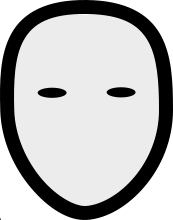
The final is people with high empathy and creativity. They tend to have thinner eyes.
People with this type look coldhearted due to their thinner eyes. And they tend to doubt common sense because they often have strange natures. In addition, they don’t get along quickly with people because they are sensitive. These characteristics make them look coldhearted.
But they are highly empathetic people. They tend to want to help others. But they are not good at socializing.
So, they use creativity to help others. Sometimes, great innovators who help others have this face. They often help people with their products or ways instead of helping them directly.
We seldom find this type because it is the minority. In addition, they prefer to live in a quiet place to a crowded one.
Sometimes, they mind their thin eyes and desire to have eyes with height. But the eyes are a sign of great creativity. If you are this type and mind your eyes, you don’t need to mind them. The eyes indicate your talent. You don’t need to pretend to be another type.
Attractiveness of every face
These explanations above are extreme examples. Almost all people have more complex characteristics. I know a highly empathic person with a squared face. I also know an innovator who has a rounded face. My explanations are just extreme examples.
But perhaps this tendency is universal because I saw it in various races.

When you saw the cartoon faces above, you might have had some impressions of them. Perhaps my explanation and your impressions were not so far away. In other words, the faces of cartoons often imply the characteristics of humans.
And the readers of this blog may tend to be highly empathic. In my case, I have thinner eyes. I sometimes thought that someone who had bigger eyes seemed attractive. But now I love the shape of my eyes. This is a sign of my creativity. And I love both higher eyes and thinner eyes.
Conclusion
So, I introduced the face types by characteristics.
Every characteristic has pros and cons. They are not inferior things.
This way of thinking might help us accept not only others’ characteristics but also ours.
Thank you for reading this article. I hope to see you at the next one.
